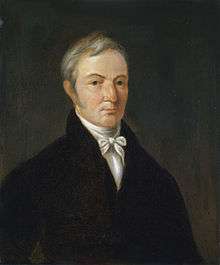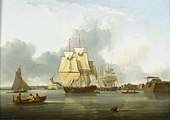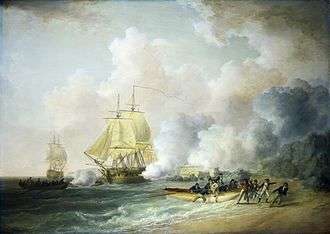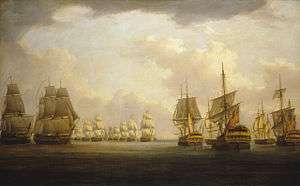William Anderson (artist)
William (or Wiliam) Anderson (1757 – 27 May 1837) was born in Scotland and became an artist specializing in maritime and patriotic themes.[1]

Life
Anderson's training as a shipwright stood him in good stead when he became an artist specializing in maritime art based on the Dutch 17th century Masters. He first exhibited at the Royal Academy in 1780 and continued to exhibit annually until 1811. He then exhibited intermittently until 1834. His best work was executed in the years 1790–1810, during the French Revolutionary and Napoleonic Wars, at which time the demand for naval paintings was high. His painting was not restricted to marine subjects.
Commissions that took Anderson back north introduced him to the Hull school of painters, notably the young John Ward (1798–1849), whom he influenced. He also was a friend of the painter Julius Caesar Ibbetson (1759–1817).
Works
For Rees's Cyclopædia he contributed drawings for the engravings, perhaps of marine topics.
His pictures, shown at exhibitions, include A View of Berwick-on-Tweed and A View of Tynemouth. His history paintings include The Battle of Waterloo, The Capture of Fort Louis, Martinique, 1794, which shows the attack by Commander Robert Faulknor of Zebra on Fort Saint Louis (Martinique), The Battle of Cape Finisterre, The First Battle of Groix and The Battle of the Nile . Other paintings include Shipping on the Thames at Deptford and View at the Mouth of the Thames .[2]
- Selected works

 Capture of Fort Saint Louis, Martinique, 1794
Capture of Fort Saint Louis, Martinique, 1794 The Battle of Cape Finisterre
The Battle of Cape Finisterre
Family
Anderson and his wife Sarah had two sons, William and George. Anderson's son, William Guido Anderson, served in the Royal Navy and was fatally wounded at the Battle of Copenhagen in 1801, as a midshipman on HMS Bellona. His son, George Anderson. was also a painter.
References
- Radford, Ernest. William Anderson, Dictionary of National Biography.
- "View at the Mouth of the Thames". Art UK. Retrieved 8 April 2012.
- Attribution
![]()
External links
![]()